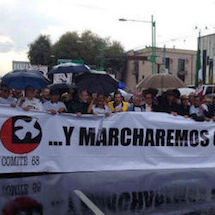
Forty-seven years after the Tlatelolco student massacre, a new generation of students marched to demand an end to impunity and repression in Mexico.
![]()
Source: CIP Americas
Forty-seven years after the Tlatelolco student massacre, a new generation of students marched to demand an end to impunity and repression in Mexico. United with the parents of the disappeared teachers’ college students of Ayotzinapa, families, and leaders of the ’68 student movement, students marched to commemorate the massacre and repression of hundreds of student activists on Oct. 2, the eve of the Summer Olympics in Mexico City in 1968.
As an act of resistance and remembrance, the march is a yearly opportunity to bring together generations, in reflection and solidarity, to commemorate the Tlatelolco massacre and confront ongoing violations of human rights and state crimes in Mexico.
The march from Tlatelolco to the Zocalo plaza is organized by the Committee of ’68, an organization comprised of survivors and activists of that movement. The committee organizes a lively and celebratory march attended by thousands of students and collectives to express school and student pride and raise awareness and protest issues affecting them today.
Walking southbound by the Bellas Artes Palace on the way to the Zocalo, in a soundscape of university chants, Madeline Vega, first-year communications student from UNAM’s Fes Acatlan, explained that the march is an opportunity to link both past and present struggles.
It’s not forgotten nor forgiven!–2 de Octubre, Acteal, Atenco, Xochicuautla, Ostula, Juarez.
“I came to the march because I’m outraged at the violence in my country. Because I can’t believe students were massacred forty-seven years ago, for protesting much the way we’re doing now. I don’t think we should ever forget, because we can also be murdered and disappeared. And that’s why I’m here—because oblivion is dangerous.”
High school students marched too, showing that political and social awareness among students begins early. For Juliana Serrano from the UNAM Gabino Barrera High School, the march has a symbolic importance.
“Although it is not in a sense, a direct action, it seems that the march of October 2 always pressures the impostor and corrupt government we have. This is an important politicization for many young people and participants. I think it’s an important march that has the potential to influence and inspire greater awareness about injustice and repression, both past and present,” Serrano told the Americas Program as she headed for the Zocalo alongside her classmates.
This year, the committee dedicated the march in memory of Raul Alvarez Garin, the historic leader of the movement who died last year, and called for justice for victims of crimes against humanity, including the victims of the Tlatlaya massacre, and punishment of the perpetrators who have yet to be punished for the murders. They also demanded an end to militarization, an end to the energy and structural reforms, respect for unions and for the Yaqui people’s right to land, and justice in the Ayotzinapa case.
Committee of ’68 at the rally at Zocalo, Mexico City’s main plaza.
At the rally that concluded the march, Felix Hernandez Gamundi, leader of the committee, called for an end on the attacks on young people and the general population. Standing on the stage in front of the heavily guarded national palace, Gamundi’s voice resounded.
“We led the march with this banner that reads ‘Stop the war against the people.’ This violence is directed at students and especially women and we have to stop it. We have to construct a better country, where we are owners of our resources and destiny.”
During the march, while survivors of the student massacre waved flags and hoisted banners imprinted with an Op-art image of a dove ironically the symbol of peace selected by the Mexican government to represent the 1968 Olympic games, young students carried banners illustrating a turtle, the symbol of resistance that represents the Raul Burgos Ayotzinapa Rural School. Banners carried on the march read, “Justice takes time, but when it arrives, it is unrelenting.”
In a recent social media post, the Committee of ’68 published the symbols side-by-side, with the words: “We demand the liberation of the truth. And to demand the liberation of the truth is to demand that the turtles of Ayotzinapa be allowed to return home, bringing with them truth and justice. It’s to demand that the truth denied us for so long come to light. It’s to recognize that the State continues to murder, disappear and execute, like it did forty-seven years ago, and that there is still truth to build outside of impunity.”
“Until justice prevails among us.”
“Until justice prevails among us.”
Student activists of present and past generations walked side by side, occupying entire city streets together. They share a conviction to resist and remember those who have fallen victims to state crimes. The enduring violence against students, and a genuine demand and commitment to justice—no matter how long those fight for justice take—unites students and people of all generations in Mexico.
Chorusing “October 2 is not forgotten!” and “Long live Ayotzinapa!”, protestors encouraged and reminded observers and participants about memory’s power to mobilize and unite people and struggles. United under a call for justice extended through decades of impunity, the fight for justice for the victims of state repression came alive at the march, inspired by the fierce activist spirit of Mexico’s students.
Nidia Bautista is the managing director for the CIP Americas Program and writes about student protest, transborder social movements, and gender issues in Latin America.
